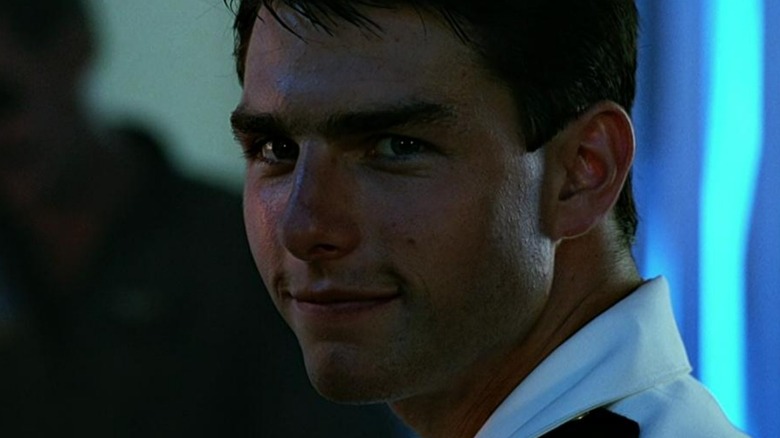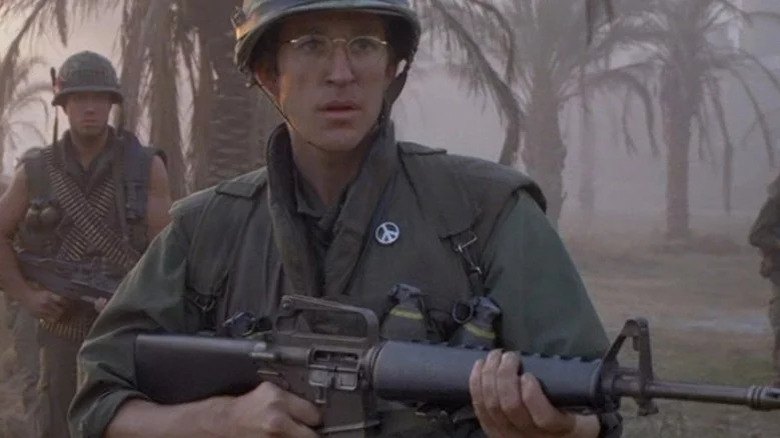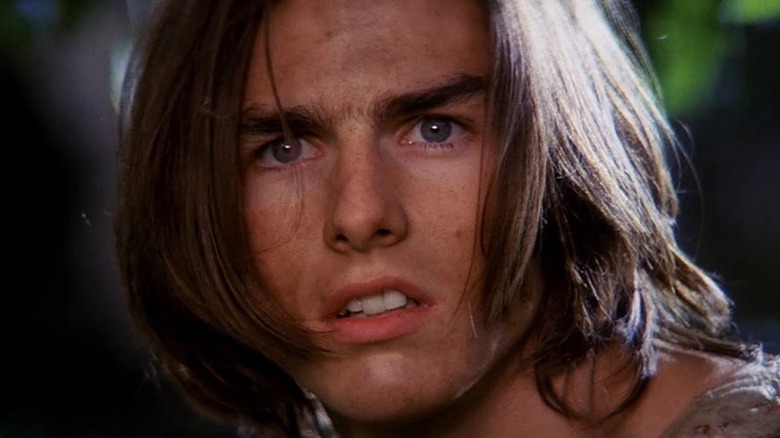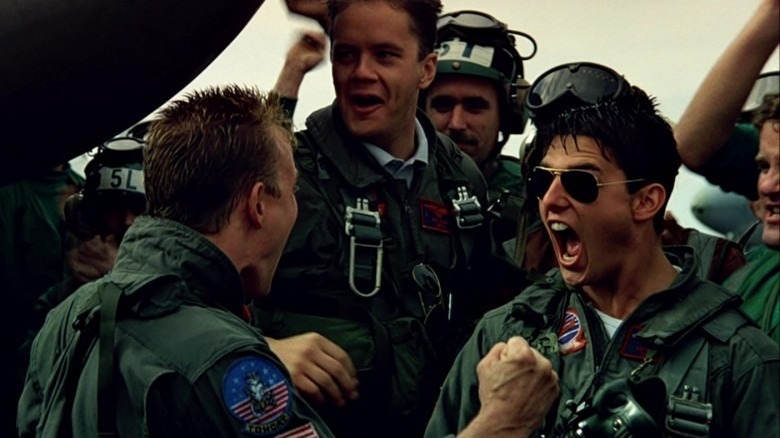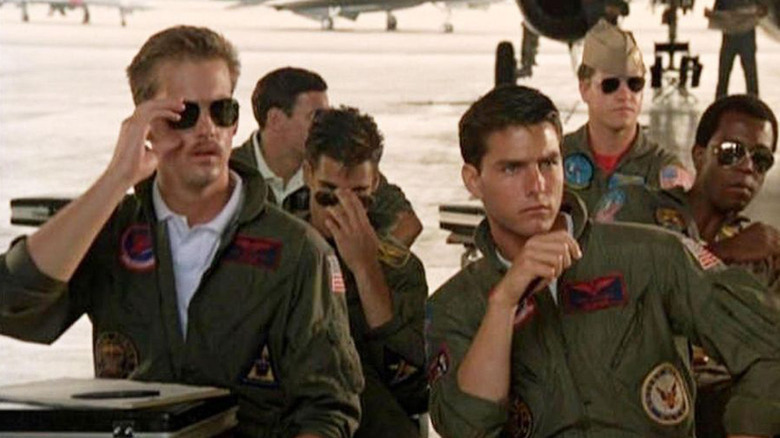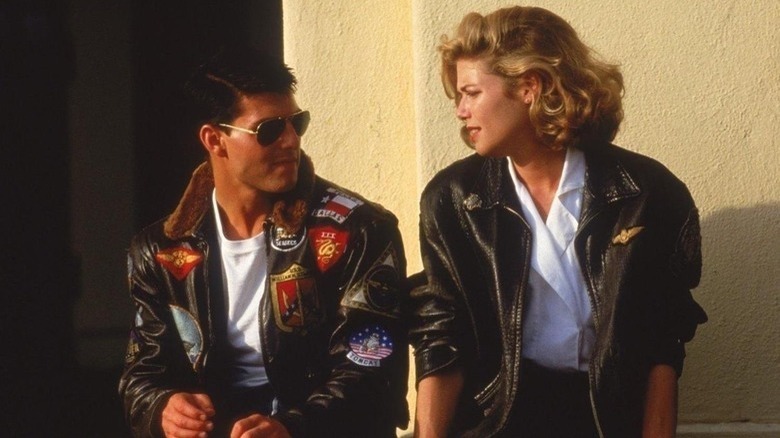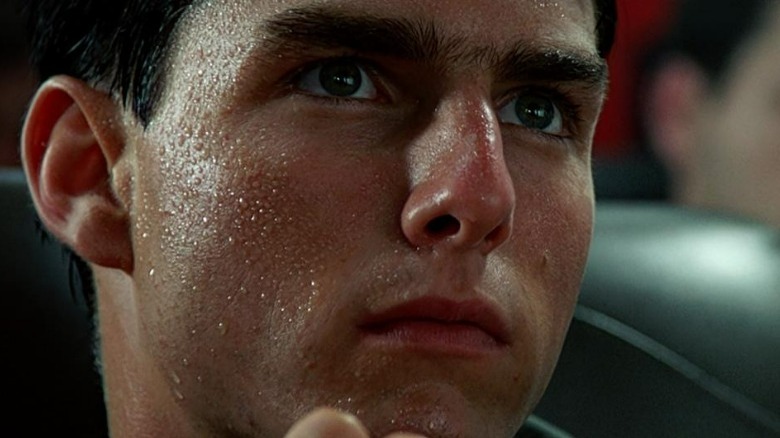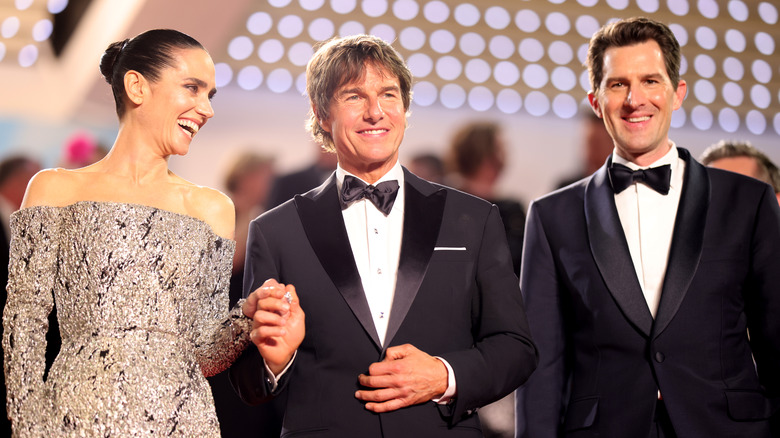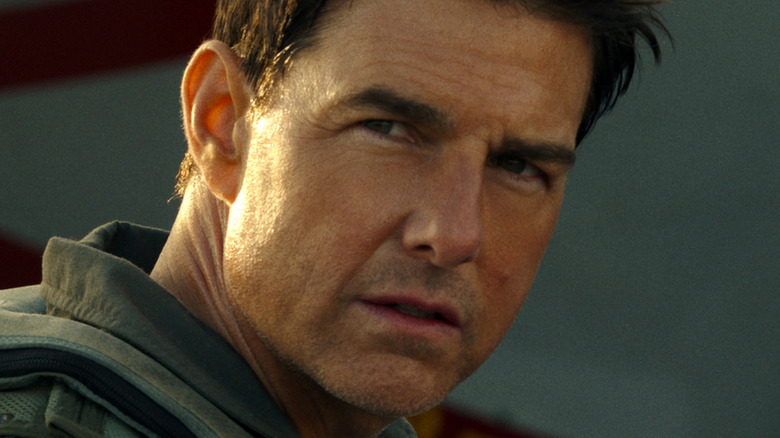The Untold Truth Of Top Gun's Pete 'Maverick' Mitchell
Do you ever feel the need ... the need for speed? If so, you may have something in common with Pete "Maverick" Mitchell, the high-flying hero of Tony Scott's 1986 film "Top Gun." If you're not familiar with the film, here's the gist of it: Maverick (played by Tom Cruise), is a cocky, hotshot pilot who is sent to the Top Gun Naval Fighter Weapons School to sharpen his skills. Maverick's recklessness and arrogant behavior don't win him any friends at the academy, and he develops an intense rivalry with another pilot named Iceman (Val Kilmer). All the while, Maverick endeavors to win the favor of a beautiful instructor, Charlie (Kelly McGillis).
Maverick is one of Tom Cruise's most legendary characters, and "Top Gun" remains one of his most enduring films. With the release of the sequel, "Top Gun: Maverick," over 30 years later, there has been a renewed interest in Cruise's role in the film. But who is Maverick, really? And what part did Cruise have in creating this classic character? If you want to learn more about the magic behind the man, then you've come to the right place. Read on to discover the untold truth of the most notorious fighter pilot in "Top Gun."
Matthew Modine was offered the role of Maverick but turned it down due to politics
It's nearly impossible to imagine Maverick being played by anyone other than Tom Cruise. But, as it turns out, another actor was actually offered the part before Cruise came on board.
The part was initially offered to actor Matthew Modine, who turned down the role because he didn't agree with the film's politics. He went on to star in Stanley Kubrick's "Full Metal Jacket" instead, a role that remains one of his most memorable. Speaking with Salon in 2020, Modine has said he does not regret turning down the role in "Top Gun" all those years ago, despite what it did for Cruise's career. "Cruise said that he felt that 'Top Gun' was a movie about individualism and personal strength. I just thought the movie was jingoistic," Modine said.
While "Full Metal Jacket" is also about the U.S. military, Modine maintains that it does not endorse the actions of the military, but rather indicts the regressive, violent values that these institutions espouse. Cruise told Playboy (via Gizmono) that "Top Gun" was never meant to represent the reality of the U.S. military and was created for purely entertainment purposes, despite the fact that the Navy was involved with the film from the start.
Cruise was cast in the film because of his work with Ridley Scott
When it came down to casting "Top Gun," director Tony Scott relied on someone he could trust: a member of his own family. Prior to "Top Gun," Tom Cruise was working on a film called "Legend," which was directed by legendary filmmaker Ridley Scott. Ridley Scott also happens to be Tony Scott's brother.
In an interview for the 30th-anniversary release (via EW) of the film, Cruise recalled that he was first offered in the film in 1983, but that "at this time I was off in London working with Ridley Scott ... And I remember I didn't address 'Top Gun' during that time period, I was focused on shooting 'Legend.'" Though "Legend" wasn't received very well by critics, Cruise maintains that it was a hugely important learning experience for him and taught him a lot about the work that goes into making a film.
Then, at the end of 1984, "Ridley said, you know, you gotta meet my brother. And he's gonna direct this film, 'Top Gun.' You know, it's aligned with things that I love: movies and aviation." By this point, Cruise was in a position to accept the role of Maverick, and the rest, as they say, is history.
Cruise shadowed real-life pilots as research for the role
It's now a well-known fact that Tom Cruise takes his work as an action star very seriously, taking the time to really prepare for his roles and often doing his own stunts. In the case of "Top Gun," Cruise did what one would imagine he would do to prepare for the role: he shadowed-real life pilots.
According to TIME, TOPGUN is the nickname of a real military school called the Navy Fighter Weapons School that was founded in 1969, at the height of the Vietnam War. As part of his training for the role, Cruise shadowed pilots at the school, whose headquarters at the time were located in Miramar and San Diego. While there, Cruise reported that an instructor told him there were "only four jobs in the world worth having: an actor, a rock star, a jet fighter pilot, and President."
Kelly McGillis, who played Maverick's love interest, Charlie, shadowed the woman her character was based on -– Christine Fox, a woman who worked at the Center for Naval Analyses. In 2013, Fox was was named acting deputy defense secretary by President Barack Obama, making her the highest ranking woman to ever serve in the Department of Defense.
Maverick and the other characters in the film were inspired by a magazine article
What does "Top Gun" have in common with films like "The Bling Ring" and "Hustlers," you ask? Well, as it turns out, all of these films were inspired by magazine articles. The magazine article in question was titled "Top Guns," and it was published by California Magazine in 1983. Author Ehud Yonay wrote about the high-octane world of fighter pilots, and a number of photographs of the school and its graduates were also included in the piece.
One element of the film that was clearly inspired by the article is the nicknames of the pilots. Though names like "Maverick" and "Iceman" were created for the film, Yonay writes in the article of pilots called things like "Yogi", "Gringo", "Gator", and "Possum." While there's not a specific pilot mentioned in the article that directly inspired Maverick, Yonay writes compellingly about the intensity of the job and how many pilots lived for the "glorious and terrifying" thrill of flying tomcats.
These days, because "Top Gun" has made the real school so famous, students at the Navy Fighter Weapons School are actually fined $5 every time they reference the film while at the academy. Retired Navy commander Guy "Bus" Snodgrass noted in his book "TOPGUN's Top 10: Leadership Lessons from the Cockpit" (via Outsider) that this rule is meant to keep pilots focused on the task at hand.
Cruise feigned disinterest in the role so he could fly with the Blue Angels
Tom Cruise and "Top Gun" producer Jerry Bruckheimer actually have pretty different stories about how Cruise came to be cast as Maverick. In an interview with Variety, Bruckheimer said that it took considerable effort to get Cruise to sign on to the film. "We wanted Tom after we saw 'Risky Busines'" and he kind of hemmed and hawed. So we arranged for him to fly with the Blue Angels at the Naval Air Facility in El Centro, California. He drove up there on his motorcycle and he had just finished a movie with Ridley Scott, 'Legend,' and his hair was long and in a ponytail," Bruckheimer said. The pilots thought Cruise looked like a hippie, so they decided to give him the ride of his life in order to scare him do death. But, as Bruckheimer tells it, this is actually what convinced Cruise to do the movie.
But Tom Cruise has said this wasn't actually how it went down. Speaking with Jimmy Kimmel, Cruise revealed that he was immediately on board with the film, but he didn't want to let Bruckheimer know right away. "I told my agent, 'I'm gonna make this movie. But don't tell Jerry that I want to make this movie,”' Cruise said. He claimed that the reason he didn't reveal his excitement about the project at first was that he wanted the opportunity to fly with the Blue Angels –- something Bruckheimer was happy to provide for him. While Cruise may have spent much of his first flight with the Blue Angels vomiting all over the cockpit, he maintains that it was well worth it in the end.
Measures were taken to hide the heigh difference between Tom Cruise and Kelly McGillis
Though he may wish this weren't the case, it's become a well-known fact that Tom Cruise isn't the tallest guy out there. He's reportedly around 5'7, which means his female co-stars are sometimes significantly taller than he is. This happened to be the case in "Top Gun," where Cruise starred opposite Kelly McGillis, who stands at around 5'10 inches tall. As such, measures needed to be taken for the scenes they shared to make them closer in height.
According to McGillis herself, she had to go shoeless for much of the film. Speaking with The Oklahoman, McGillis recalled "Well first off, Tom and (director) Tony (Scott) and I really weren't bothered by the height difference, but apparently Paramount was, so I acted the whole time in my stocking feet." McGillis noted that while she had a great time making the film, looking back she can now see that she was trying to "shrink" herself more and more as the film went on. Nonetheless, the experience was something McGillis is used to, as she wryly recalled that "There've been a lot of men that I've worked with that I don't wear shoes with."
Tom Cruise wasn't allowed to fly an F-18 in Top Gun: Maverick
Unsurprisingly, given that it's a blockbuster sequel, everything in "Top Gun: Maverick" is bigger and badder than it was in the original. There are bigger, faster jets, more realistic action sequences, and even drones in the new film. While all of these advancements were necessary for updating the film and aligning it with contemporary technology, it also meant that Cruise couldn't quite do everything himself this time.
Though Cruise is an experienced pilot himself, Jerry Bruckheimer admitted that the Navy denied Cruise's request to pilot the F-18 Super Hornet jet that Maverick flies in the film. Despite this, Cruise took it upon himself to pilot every other aircraft he could. "The Navy wouldn't let him fly an F-18," Bruckheimer told Empire. "But he flies a P-51 in the movie and he flies helicopters. He can do just about anything in an airplane."
In order to get around the fact that Cruise couldn't pilot the F-18 himself, producers engineered some pretty ingenious camera setups. Cruise was adamant that the film not rely on CGI, so instead, IMAX cameras were actually installed inside F-18s while Navy pilots did the actual flying. Bruckheimer maintains that this setup still gives audiences the experience of "what it's like to be in an F-18 in that cockpit with those pilots."
Cruise once said making a sequel to Top Gun would be irresponsible
In the first couple of decades of his career, Tom Cruise was adamant that he didn't want to make sequels for any of his films. This all changed when he starred in the first "Mission: Impossible" film, which spawned five (and counting) sequels. According to Cinema Blend, he eventually decided that sequels could be a fun challenge for the cast and crew.
For many years, Cruise was also similarly disinterested in making a sequel to "Top Gun." In fact, in 1990, Cruise went so far as to say making a sequel to the film would be "irresponsible." In an interview that was recently unearthed by Variety, Cruise spoke to Playboy magazine about the possibility of a sequel. "Some people felt that 'Top Gun' was a right-wing film to promote the Navy. And a lot of kids loved it. But I want the kids to know that that's not the way war is — that 'Top Gun' was just an amusement park ride, a fun film with a PG-13 rating that was not supposed to be reality," Cruise said at the time. "That's why I didn't go on and make 'Top Gun II' and III and IV and V. That would have been irresponsible."
This was 32 years ago now, so we don't blame Cruise for changing his mind on the subject since then. Many would argue Cruise was right to do so, as "Top Cruise: Maverick" has been met with a largely positive response from critics.
The director of Top Gun: Maverick pitched his idea for the sequel to Cruise directly
Despite Cruise's hesitance to sign on for a sequel to "Top Gun" for many years, director Joseph Kosinski was eventually able to convince him. After Tony Scott died in 2012, it was up to Kosinski to make sure the legacy of Scott's film was honored.
Part of Kosinski's pitch had to do with the journey that Maverick would go on in the film, and the first step in getting the film made was to pitch the idea to Cruise himself. As Kosinski told Deadline, "I started the discussion with what I thought should be the emotional core of the film: the severed relationship between Maverick and Goose's son set against a dangerous combat mission that would take them both deep into enemy territory. As soon as I said that, I could see the wheels in Tom's head starting to turn."
Kosinski went on to say that the latter half of his pitch revolved around what Maverick would be doing in the Navy at the time the film is set, an idea that became the "Darkstar" sequence at the start of the film. Kosinski also told Cruise that they were thinking of rigging cameras inside the cockpit of the jets and that, perhaps most importantly, it shouldn't be called "'Top Gun 2', it should be 'Top Gun: Maverick' because it is a character driven rite-of-passage story just like the first one." (Cruise would go on to reiterate the importance of the title in an interview with Access Hollywood.)
According to Kosinski, Cruise was immediately on board following the conversation, even going so far as to call up the head of the studio immediately after he heard Kosinski's pitch.
The Navy answered questions about why Maverick is still a Captain in the sequel
When the trailer for "Top Gun: Maverick" was released, some fans were skeptical as to why Maverick would still be a Captain in the Navy after more than 30 years of service. Wouldn't he have advanced to the rank of Admiral by then? In fact, this issue is actually addressed in the trailer itself, when his superior, played by Ed Harris, berates his behavior, "You can't get a promotion, you won't retire, and, despite your best efforts, you refuse to die. You should be at least a two-star admiral by now. Yet here you are. Captain," he tells Maverick.
While this does address the elephant in the room, it doesn't actually answer the question of why Maverick is still a captain. This question became so controversial that the Navy felt compelled to provide answers. The Navy Personnel Command spoke with USNI news about how this turn of events could have happened.
This first explanation could be that the captain in question had "previous enlisted experience," but this doesn't fit the timeline of Maverick's career. Another explanation would be if Maverick had left active duty sometime after the events of the first "Top Gun" film and spent several years in the Navy Reserves. The final scenario would be if Maverick was "retired but retained in service, a scenario that keeps individuals in uniform after reaching their statutory retirement." This situation is unlikely, as most people do not serve past their mandatory retirement, but the Navy says it is possible.
We imagine that the writers of "Top Gun: Maverick" weren't thinking quite that hard about the implications of Maverick's military rank, but clearly, someone at the Navy is.
